 Sundarban
Sundarban
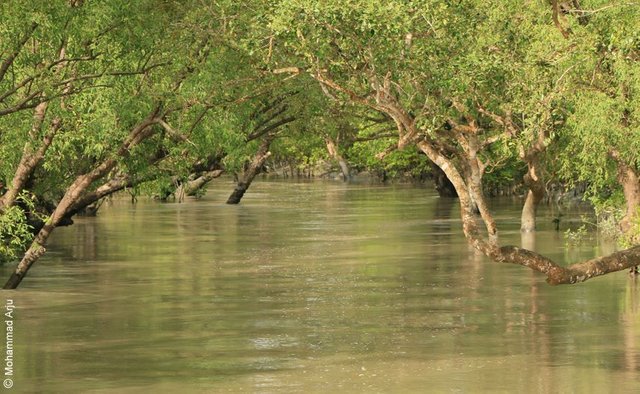
Sundarban:World largest mangrove forestGeneral Description
Sundarban is the biggest mangrove forest in the world. Sundarban is in South West part of Bangladesh, in the district of greater Khulna. India shares a bit of the forest with Bangladesh. The total area is about 38,000 square kilo meters. Sundarban is a large block of littoral forests. The beauty lies in its unique natural surrounding. The Sundarbans are a part of the world's largest delta formed by the rivers Ganges, Brahmaputra and Meghna. Thousands of meandering streams, creeks, rivers and estuaries have enhanced its charm. For miles and miles, the lofty treetops form an unbroken canopy, while nearer the ground, works of high and ebb-tide marked on the soil and tree trunks and the many varieties of the natural mangrove forest have much to offer to an inquisitive visitor.
Sundarban is the natural habitat of the world’s famous Royal Bengal Tiger, spotted deer, crocodiles, jungle fowl, wild boar, lizards and many more. Migratory flock of Siberian ducks flying over thousands of sail boats loaded with timber, Golpata, fuel wood, honey, shell and fish further add to the serene natural beauty of the Sundarban.
Location and history
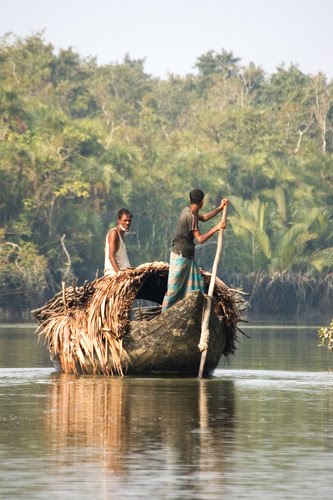
The Sundarban Reserved Forest (SRF), occupying an area of around 6,017 square kilometres or 600,000 hectares, represents 51 percent of the total reserved forest area of Bangladesh and as such forms a rich and diverse ecosystem with potential for sustainable natural resource management. Man has exploited the Sundarban for centuries but the forest was not given Reserve status by the Forestry Department until 1875.
managed the forest and other natural resources of the SRF through adherence to management plans which it prepares at regular intervals.Early management simply concentrated on revenue collection and the enforcement of felling rules to reduce overcutting, particularly in the eastern portion. The first real professional forest management planning was introduced in the SRF in the early 1900s with the introduction of the Curtis Working Plan.
However, more recently forest resource management has shifted to increase emphasis upon environmental and socio-economic issues.
The following table presents the fractions represented by forest and other land types in the Sundarban.
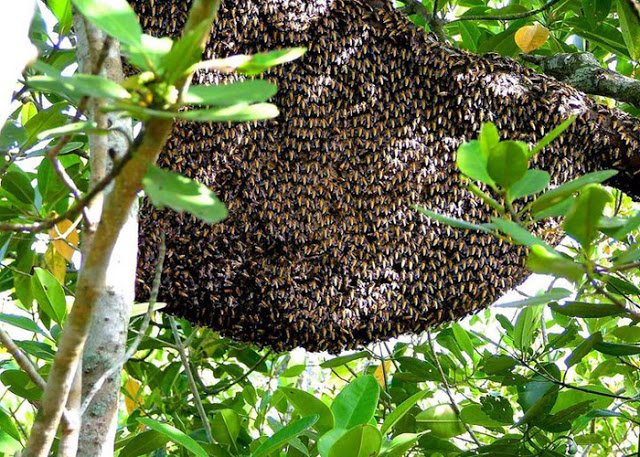
Famous spots

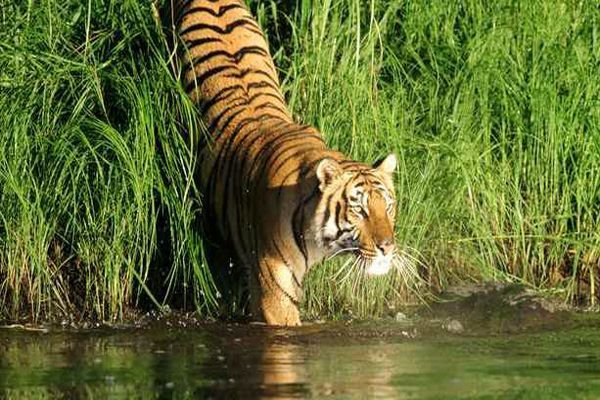
The main tourist point is Hiron Point (Nilkamal) for watching tiger, deer, monkey, crocodiles, birds and natural beauty. Katka is for watching deer, tiger, crocodiles, varieties of birds and monkey. Morning and evening symphony of wild fowls. Vast expanse of grassy meadows running from Katka to Kachikhali (Tiger Point) provide opportunities for wild tracking. Tin Kona Island for tiger and deer. Dublar Char (Island) for fishermen. It is a beautiful island where herds of spotted deer are often seen to graze. Here land and water meet in many novel fashions, Wildlife presents many a spectacle. No wonder, you may come across a Royal Bengal Tiger swimming across the streams or the crocodiles basking on the river banks. With the approach of the evening herds of deer make for the darkling glades where boisterous monkeys shower Keora leaves from above for sumptuous meal for the former. For the botanist, the love of nature, the poet and the painter this land provides a variety of wonder for which they all crave.
Biodiversity of Sundarban
The Sundarban is the largest contiguous block of mangrove forest remaining in the present day world and a large unique mangrove ecosystem, recognized as a site of national and international importance for conservation of biodiversity. This forest is an independent "Biome", enriched with different biodiversities along with a great variety of wild life. Besides dolphins and porpoises, Sundarban mangroves are habitats of many rare and endangered animals (Batagur baska, Pelochelys bibroni, Chelonia mydas), especially it is the unique natural habitat of the world famous Royal Bengal Tiger (Panthera tigris), spectacular spotted deer (Axix axix), jungle fowl (Gallus sp.) and rhesus monkey (Macaca mulata). The forest has a unique biota comprising 334 species of plants, 49 species of mammals, as many as 400 species of fish, 315 species of birds and 53 species of reptiles; besides numerous species of phytoplankton, fungi, bacteria, zooplankton, benthic invertebrates, mollusks, reptiles, amphibian and mammals. Species composition and community structure varies east to west, and along the hydrological and salinity gradients. Ecologically, the forest is particularly important as a barrier to cyclones, tidal upsurges, etc. It is also acting as a huge sink of unlimited capacity for absorbing CO2 and other pollutants from air and water which makes the surrounding environment free from pollution.
The mangroves of the Sundarban are unique when compared to non-deltaic coastal mangrove forest. Unlike the latter, the Rhizophoraceae are of only minor importance and the prime species are sundri (Heritiera fames), from which the Sunpaludosa on drier soils. Dhundal and passur (Xylocalpus spp), and Bruguiera occur sporadically throughout the area. Sundri and gewa cover most of the Sundarban but Oryza coarctata, Nypa fruticans and Imperata cylindrica are prevalent on mud flats. Large stands of keora (Sonneratia apetala) are found on newly accreted mud banks and provide important wildlife habitat.
The Sundarban is the only remaining habitat in the lower Bengal Basin for a variety of fauna1 species. The presence of 49 mammal species has been documented. Of these, no less than five spectacular species, namely Javan rhinoceros Rhinoceros sondaicus (CR), water buffalo Bubalus bubalis (EN), swamp deer Cervus duvauceli (VU), gaur Bosfrontalis (VU) and probably hog deer Axis porcinus (LR) have become locally extirpated since the beginning of this century. The Sundarbans of Bangladesh and India support one of the largest populations of tiger Panthera tigris (EN), with an estimated approximately 700 (2004). These tigers are well-known for the substantial number of people they kill; estimates range from twenty and eighty people per year. They are the only man-eating tigers left in the world, though they are not the only tigers who live in close proximity to humans.
The varied and colorful bird-life to be seen along its waterways is one of the Sundarbans’ greatest attractions. A total 315 species have been recorded, including about 95 species of waterfowl and 38 species of raptors. Among the many which may be readily seenphaga ichthyaetus (NT), Pallas’s fish-eagle Haliaeetus Zeucoryphus and several other raptors. Herons, egrets, storks, sandpipers, whimbrel, curlew and numerous other waders are to be seen along the muddy banks and on the chars or sandbanks which become exposed during the dry season. There are many species of gulls and terns, especially along the coast and the larger waterways. Apart from those species particularly associated with the sea and wetlands, there is also a considerable variety of forest birds such as woodpeckers, barbets, shrikes, drongos, mynahs, minivets, babblers and many others.
Some 53 reptile species and eight of amphibians have been recorded and of these, mugger Crocodyluspalustris (VU) is now extinct, probably as a result of past over-exploitation, although it still occurs in at least one location nearby. Estuarine crocodile C. porosus still survives but its numbers have been greatly depleted through hunting and trapping for skins.
Four species of marine turtle have been recorded from the area, olive ridley Lepidochelys olivacea (EN) being the most abundant. Green turtle Chelonia mydas (EN) is rare due to excessive fishing, while loggerhead Caretta caretta (EN) and hawksbill Eretmochelys imbricata (CR) are not common although there have been some reported on the beaches (Hussain and Acharya, 1994). River terrapin Batagur baska (EN) is also present. The eighteen recorded snake species include king cobra Ophiophagus hannah and spectacled cobra Naja naja, three vipers and six sea-snakes(S alter, 1984). Over 120 species of fish are reported to be commonly caught by commercial fishermen in the Sundarban. Freshwater species are alarmingly decreased day by day. Crustacea account for by far the largest proportion of ah waters of the Sundarban also yield a considerable harvest of shrimps, prawns and lobsters. The area supports a varied insect population including large numbers of ants, honey-bees etc. and honey and beeswax are economically very important products. The insect life of the Sundarban has been little studied.
Protection Status of the Sundarban

The Sundarban Forest covers 10,000 km2 of mangrove forest west of the main outflow of the Ganges, Brahmaputra and Malancha rivers. Around 60 % of this area is part of Bangladesh territory and entirely gazetted Forest Reserve, which was a phaervation Project has identified a so-called "Impact Zone" where most of the direct users of the forest are residing.
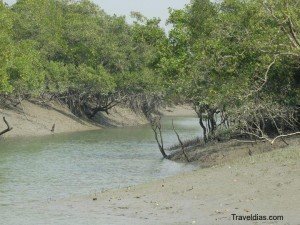
Hi! I am a robot. I just upvoted you! I found similar content that readers might be interested in:
http://bangladeshqueenofnaturalbeauty.blogspot.com/p/sundarbanworld-largest-mangrove-forest.html
Downvoting a post can decrease pending rewards and make it less visible. Common reasons:
Submit